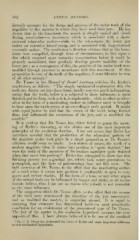Page 492 - My FlipBook
P. 492
502 DENTAL ANATOMY.
factorily accounts for the forms and patterns of the molar teeth of the
ungulates by the manner in which they have used their jaws. He has
shown that in the bunodonts the mouth is simply opened and closed
during mastication—a movement which is associated M'ith a short-
crowned tubercular molar—while in the selenodonts the lower jaw
makes an extensive lateral sweep, and is associated with long-crowned
crescentic molars. The conclusion is therefore obvious that as the buno-
donts were compelled, through force of circumstances, to live upon a
diet which required more extensive comminution before it could be
properly assimilated, they gradualy develop greater mobility of the
lower jaw ; as a consequence of this, the patterns of the molar teeth were
modified through pressure in accordance with this movement. If this
proposition be true of the teeth of the ungulates, it must likewise be true
of all other animals.^
Dr. Tomes in his JIanual of Dental Anatomy criticises Mr. Ryder's
conclusions, as follows : " The simple mechanical explanation that the
teeth are drawn out into these forms hardly conveys much information,
seeing that the tooth, before it is subjected to these influences, is quite
finished, and its form, such as it is, is unalterable ; while to effect an alter-
ation in the form of a masticating surface an influence must be brought
to bear upon the tooth-germs at an exceedingly early period. It might
with equal justice be said that the crown of the tooth, being formed
thus, had influenced the excursions of the jaw, and so modified the
condyle."
It is evident that Dr. Tomes has either failed to grasp the mean-
ing of Ryder's reasoning, or else denies one of the most important
principles of the evolution doctrine. I am not aware that Rvder has
anywhere asserted that the production of the selenodont pattern of
the ungulate molar took place in a single generation, as Dr. Tomes's
criticism would seem to imply. As a matter of course, the tooth of a
modern ungulate when it comes into position is " quite finished," but
were the teeth of the ancestors of the modern ungulates quite finished
when they came into position ? Ryder has attempted to show that this
finishing process was a gradual one, which took many generations to
accomplisli, and the facts of palaeontology bear out this view. The
bold assertion of Dr. Tomes, to the effect that the masticating surface
of a tooth wlien it comes into position is unalterable, is open to very
grave and serious doubts. If the firm of a bone or any other organ
of the animal body can be influenced by imjiact and strain, as all evolu-
tionists believe, then I can see no reason why a tooth is not amenable
to the same influences.
The sugge.stion which Dr. Tomes offers, to the effect that tiie crowns
of the teeth have determined the direction' of tlie jaw movements,
and so modified the condyle, is somewhat absurd. It is equal to
assuming that structure has determined habit—a most remarkable
conclusion foi- an evolutionist of the ])ronounced tvpe of Dr. Tomes.
The fact of the matter is, the evolution hypothesis assumes the very
opposite of this. I have always believed it to be one of the cardinal
' Dr. C. N. Pierce ha.s elaborated the views of Ryder and made important additions
to this mechanical hypothesis.


